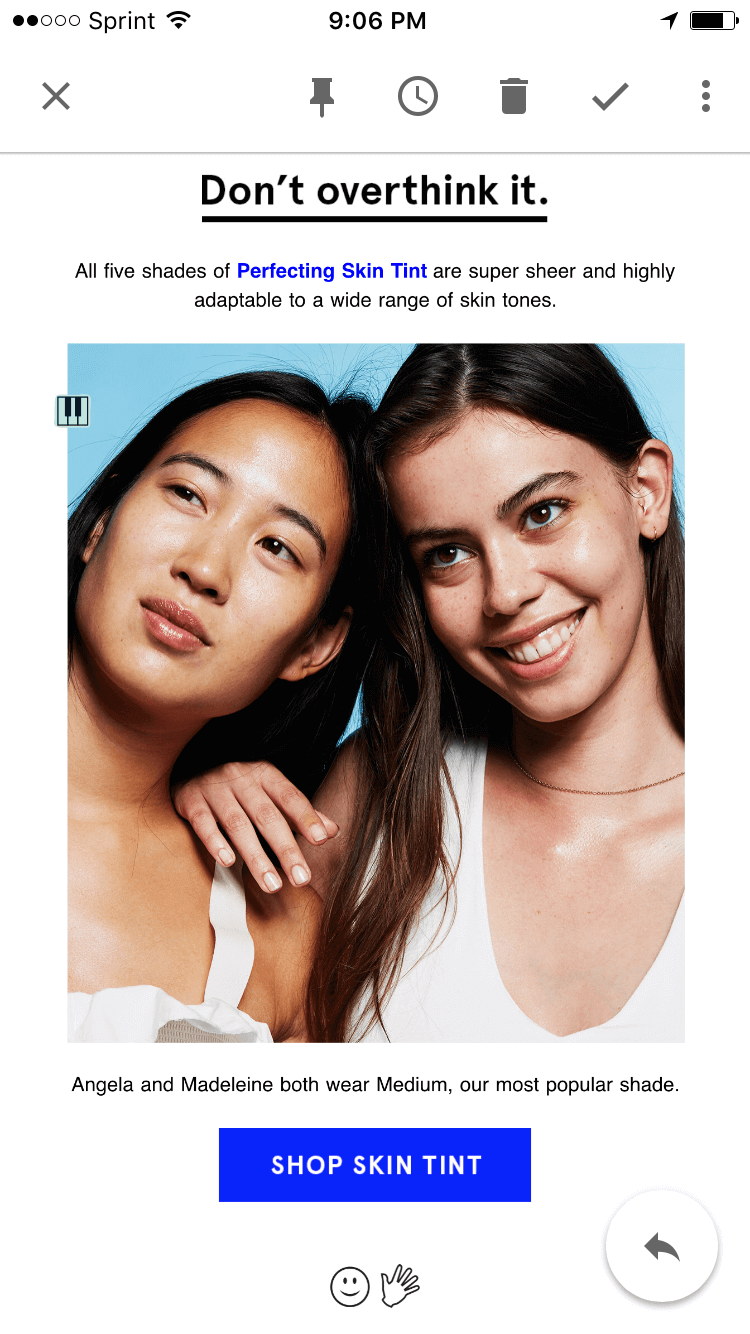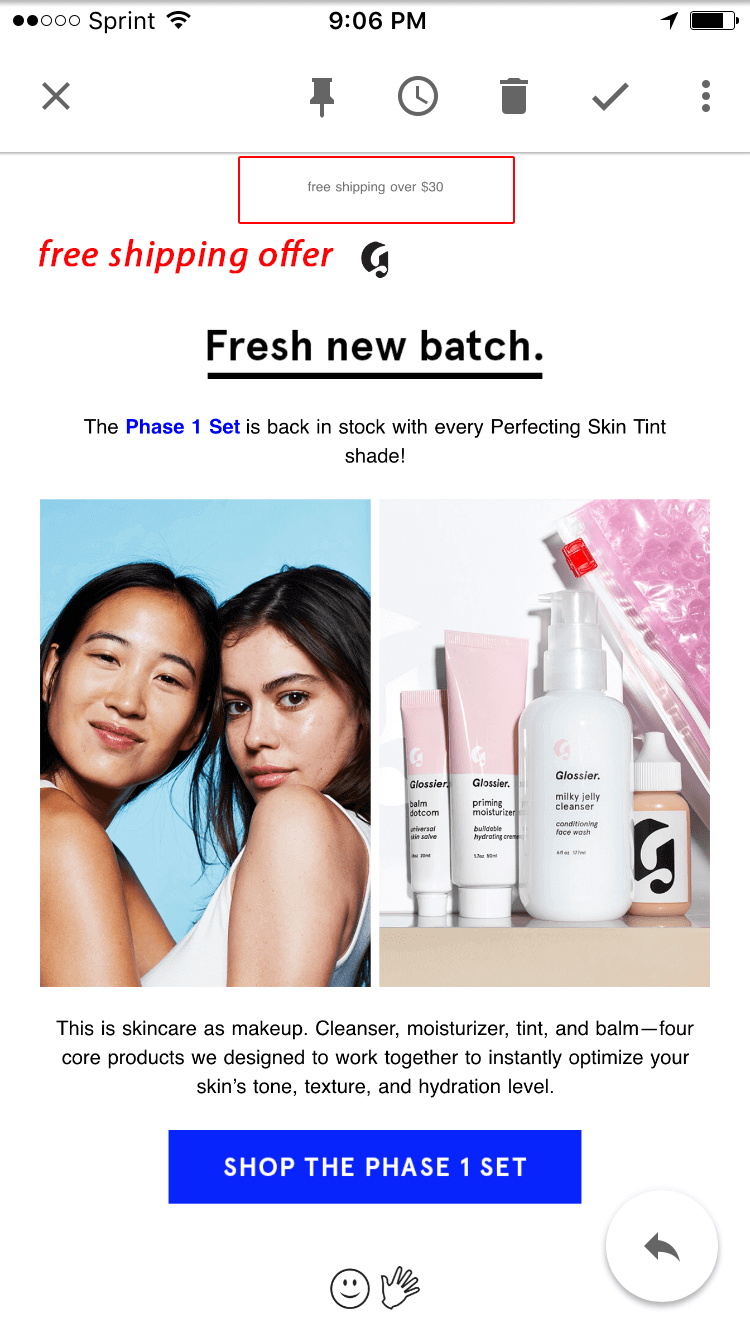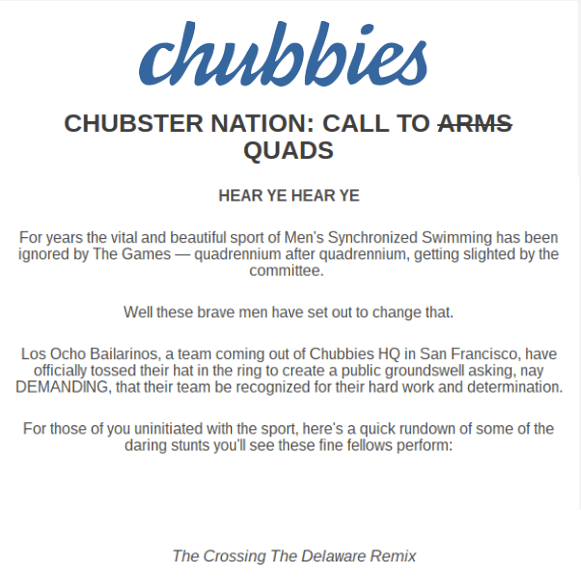Increase Your Conversions 6X With the Email Customer Engagement Tools Used by The Honest Company & Chubbies
Some brands make customer engagement look easy, don’t they?
Fast-growing brands like The Honest Company ($1 billion valuation), Chubbies (raised $4.1 million and had 50% revenue growth in 2015), and Glossier ($8.4 million in Series A funding) have customer engagement to be envious of.
Thousands of Instagram followers.
Raving fans who’ve become social media advocates.
Tons of user-generated content.
Maybe they have a significant amount of their budget dedicated to this channel, but the point is budget is not the deciding factor in whether your customers engage with your brand or not.
Successful customer engagement is a result of a well-thought out and well-implemented customer engagement strategy.
So that’s what I’m going to focus on in today’s post: what that strategy looks like and how you can implement it, too (specifically, three tools that can help you).
Use Email Customer Engagement to 6X Your Conversions
Most brands exist in more than one channel: online, brick-and-mortar, pop-up shops, social, email, third-party retail, etc. How many of these channels does your company live in?
Probably most of them, right?
Well, I’m not going to cover all of them in today’s post. Instead, I’m going to focus on one channel that can significantly improve your customer engagement level as proven by brands like The Honest Company and Chubbies.
That channel is email.
I assume you have a pretty strong customer database built (meaning you have the email addresses of your customers and / or users who have signed up for your newsletter) and that you are sending emails to this list.
But how strategic are your email campaigns in relation to your customer engagement strategy?
By honing in on specific user behaviors, like purchase rate, last item purchased, or other behaviors, you can segment your list to be more targeted and effective in engaging the recipient.
Today we’re going to examine three tools used by successful brands like Honest and Chubbies to heighten customer engagement and drive sales.
Sendgrid vs. Mandrill vs. Klaviyo for Ecommerce Marketing & Transactional Email
The three tools we’re going to talk about in today’s post are Sendgrid, Mandrill, and Klaviyo. All are transactional and marketing email platforms. They allow you to send emails purely for marketing purposes (marketing email) or based on an action taken (transactional email).
(The other big player in this space is Bronto, which we recently mentioned here.)
Sendgrid, Mandrill, and Klaviyo are pretty competitive solutions. When looking at their pricing models, there are a few differences to note. At the time of this article being published here are the differences in their pricing models:
- $80/mo. for 100,000 emails w/Mandrill. Click here to see Mandrill pricing.
- $20/mo. for 100,000 emails w/SendGrid. Click here to see SendGrid pricing.
- Klaviyo pricing is based on contacts rather than emails, but $350/mo. will get you 50,000 emails. Click here to view their structure.
What’s attractive about Sendgrid is their analytics, 24/7 live support, easy integration with a great API with good documentation, and they have a reputation for good deliverability rates.
Mandrill, on the other hand, also has nice analytics (though rather basic) and an easy setup making it very accessible for non-developers. But, it seems that Mandrill may have more issues around deliverability, reporting, and the actual interface design (see comment section here).
Klaviyo has gained a lot of traction since recently receiving a $1.5 million investment from Accomplice, an early-stage technology venture firm, and other investors. (source) They have more data points to offer than more “basic” email marketing providers and have strong segmentation functionality. (source)
With the pricing comparison out of the way, let’s take an actual look at how these fastest-growing companies are using each of these tools.
The Honest Company Uses Sendgrid to Nurture Customers Who Abandon Their Carts
We’ve written about The Honest Company and how they use trust to market to millennials before. They’re a digitally native vertical brand (DNVB) that prioritizes user experience (UX) in all steps of their conversion funnel.
When it comes to engaging with users via email, Honest uses Sendgrid to nurture a user based on their action (or inaction).
An example of engaging based on inaction that Honest does very well is abandoned cart recovery emails, one of the most underused conversion channels in ecommerce.
Here’s the sequence of how Honest implements their customer engagement email strategy when a customer adds an item to their cart then exits without purchasing (abandonment):
1 Day After Abandoning: Send First Reminder
After 1 day of abandoning their cart customers receive an email saying they “honestly” forgot something in their shopping cart.

2 Weeks After Abandoning: Send First Discount
After 2 weeks of abandoning their cart, customers receive an email with a 35% discount off their entire purchase and 3 days to use the promo code.

What’s important to note about their strategy here: they are giving a very good discount, but are also using the element of urgency to incentivize their customers to use it.
No Response to Discount: Offer Another (Better) Discount
If the customer still doesn’t bite on the Honest discount, 7 days after the previous coupon was sent, an additional discount email is sent to incentivize engagement. The previous discount was 35%. This one is 40%.

Implementing a customer engagement strategy that nurtures customers with abandoned cart email incentives allowed The Honest Company to increase their conversion rate 6X! (source)
[content_upgrade]Want to start utilizing the right conversion formula for your own site? Sign up for our FREE Conversion Training: “How to Grow Ecommerce Sales, Conversions and Profits WITHOUT Spending More on Marketing” and get a copy of our high-converting purchase funnel to start convert your CURRENT ecommerce website into a growth engine. Click here to watch the video >[/content_upgrade]
MeUndies Uses Mandrill to Recover Abandoned Carts
Like Honest, MeUndies has a strategy in place to re-engage customers who left the site without buying the items placed in their cart. Their strategy is less tiered than Honest’s several steps, and offers one reminder email and one discount email.
Here’s a look at their emails on mobile:

By offering users a 20% discount on their purchase, MeUndies is incentivizing users to buy. Note that they too use the element of urgency by placing an expiration on their discount.
Glossier Uses Klaviyo to Engage With Customers Through Strategic Imagery & Product Bundles
I have yet to really write about Glossier in-depth on our blog (we give them a brief mention in this post here), which I find surprising because I am a customer.
And I always find myself paying more attention to their emails than I should (says my wallet). So that’s a good problem for Glossier to have 🙂
They’re using Klaviyo to encourage customer engagement through email and they succeed by using two effective tactics:
- Playing on customer psychology with email imagery
- Bundling products & offering free shipping
Let’s break down their imagery strategy first:

Looking at this email I received from Glossier about their Skin Tint product, the image and the caption are spot-on. Showing an image of two women, of two different races, with two different skin-tones but that are wearing the same tint is genius!
Selling beauty products online is tricky because most people want to try them on. This image plus the caption totally dismantle any doubts a customer may have about purchasing this product, and incentivizes them to click through and engage further.
The image visually shows the customer that their product Skin Tint is built for more than just one skin tone, and can blend into a range of skin colors.
Secondly, they also know how to promote a “deal” – and they do this by emailing their customers about product bundles.

This email, for example, is promoting their Phase 1 Set (an $80 value). What important to note, though, is the very first line of the email the customer sees is the “free shipping over $30”.
The Set is priced at $80, so customers are more inclined to purchase because they’ll be getting it shipped for free.
If you don’t know how to get started with building in “free shipping” to your conversion strategy, check out this post we wrote about it here.
Chubbies Uses Klaviyo to Intrigue & Entertain Me Almost Every Day
I signed up for the Chubbies newsletter earlier this year. And I open nearly every one of their emails (which they send out almost daily).
They truly are entertaining pieces of content. Even if I’m not interested in buying anything from them, I have absolutely been incentivized to share their content.
Here’s an example:

First of all, their subject lines and “from” fields always intrigue me. In a good way. I’ve figured out by now it’s Chubbies, but in the beginning I was always intrigued to be receiving an email with such an odd sender (in this example “Hey”) and subject lines with lots of ellipses…
Clicking on this email brought me this (among other hilarious gifs):


Not only did this email make me laugh out loud at my computer, I took straight to my personal Facebook page to share this above video.
I couldn’t help myself.
Chubbies’ customer engagement strategy from their email campaigns is effective because they are filling their emails, not only with imagery of the products they want you to buy, but rich media that encourages a user to engage with them in some form or fashion.
I didn’t buy anything from that email. But, I shared the video to my own page which reached my network of friends, several of whom shared the video on their own personal page.
You can see where I’m going here.
I’ve said before that whoever is in charge of writing their email copy should be given a raise because not only is it entertaining, it proven to be effective in their customer engagement strategy.
3 Steps for You to Start Engaging More with Your Customers Now
“But my brand isn’t goofy – we can’t produce content like Chubbies and stay true to our brand messaging.”
That’s OK! You don’t have to have silliness to encourage customer engagement.
What Chubbies has nailed is they know exactly who they’re talking to, and have made some assumptions about what type of content their target demo will respond to.
That’s what you need to do, too.
Let’s look at 3 steps you need to take in order to heighten your customer engagement through your email campaigns:
1. Use Specific KPI’s
Of course you want to have several metrics set up to track your email customer engagement. Each of the tools mentioned above has an analytics feature, so you can work with that. As with any analytics, there are many metrics to track, but the most important ones for customer engagement in email are:
- Clickthrough rate (CTR): the percentage of recipients who click on a link in the email. This one is a very “standard metric”, and helps you assess if recipients are actually acting on any links given in your content.
- Long-term engagement: Measure all subscriber engagement (like open, click, download, social share, or purchase) over a set, longer time period (a quarter, six months, or a year). Assess the percentage of your subscribers on your list who are active: for example, 65% of subscribers have interacted within the last 6 months. You can set targets to improve engagement by assessing which segments (more on that below) are active in the longer term.
- Product / Category engagement: Use your analytics to understand which categories or products your subscribers most are interested in This may give opportunities for improving product recommendations. For example, if one-specific category is getting the most clicks over a 6-month time period, then you can make that category more prominent in future emails or even create a specific email targeting interest in that category.
- Sharing / Forwarding rate: Monitoring how much of your content gets shared is another good metric to measure customer engagement because it allows you to measure how likely your customers are to pass it on to a friend. Like the Chubbies example above, content can be used for more types of engagement than click to purchase.
2. Segment Your Lists
So Remember how I said Chubbies has nailed exactly “who they are talking to”? That means they’ve understood how to segment their email subscriber list to optimize for engagement.
By separating your list into segments, you allow yourself to send more targeted emails to your customers based on various criteria. Here are some examples of segmentation that ecommerce brands commonly use to increase engagement:
- Past purchase behavior: segmenting lists by a customer’s previous purchase allows you to do things like upsell with a related product. Or, if it’s an item that doesn’t last long (for example, organic baby food), it allows you to send a targeted email to re-order the product after a certain period of time.
- Geographic location: knowing where your customers live is a powerful engagement tool, especially if you have brick-and-mortar locations. You can create email campaigns to push in-store visits (like Bonobos did in this example) or you can offer customers a specific discount in a certain geographic region.
- Inactive users: looking back at your KPI’s, it’s crucial for you to know who is inactive so you can attempt to nurture that customer back to health. Having a list dedicated solely to “inactive” customers allows you to market to them in a different – perhaps less aggressive – way than your active customers. Consider putting them into a campaign that only links to blog articles (educational material) or links out to a different site with valuable information. Become valuable to these users again, and see their engagement do a 180.
Your Customers Are Ready to Engage…Now What?
OK, let’s imagine you take advantage of one of the tools mentioned above, and start getting your customer engagement strategy dialed in. Your customers are going to start clicking through to your website.
What will they land on?
For the love of all the resources you just invested in your email initiative, please don’t serve up a poor website experience.
In order for your customer engagement to be effective when a customer lands on your website, you have to continue the engagement journey by guiding them through to purchase.
Are you doing that?
We can show you if you are or not. Our FREE Conversion Workshop shows you exactly what a converting purchase path looks like from the perspective of some of the industry’s top-converting brands. You’ll learn:
- How to get more conversions from your traffic, without having to overhaul your website.
A simple system for increasing your sales AND profit margins, without spending more money on ads or SEO. - A breakdown of the exact conversion mistakes you are making and how to fix them.
- Our strategy for PREDICTABLY growing your business WITHOUT investing outside capital.
- BONUS: A map of our top-performing “pre-purchase” funnel and an ROI Calculator from Referral Candy!







